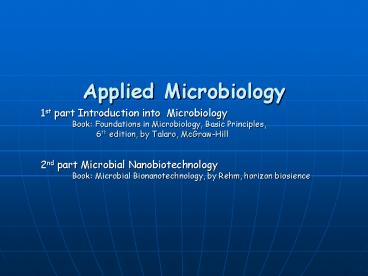Applied Microbiology - PowerPoint PPT Presentation
1 / 46
Title:
Applied Microbiology
Description:
... 7th Lecture: Chapter 8 (microbial metabolism) 8th Lecture: Chapter 13 (microbe-human interaction ... Microbe, Host - Elements of ... blood cells Plant cells Human ... – PowerPoint PPT presentation
Number of Views:2168
Avg rating:3.0/5.0
Title: Applied Microbiology
1
Applied Microbiology
- 1st part Introduction into Microbiology
- Book Foundations in Microbiology,
Basic Principles, - 6th edition, by Talaro,
McGraw-Hill - 2nd part Microbial Nanobiotechnology
- Book Microbial Bionanotechnology,
by Rehm, horizon biosience
2
Applied Microbiology
- 1st part Introduction into Microbiology
- Book Foundations in Microbiology,
Basic Principles, - 6th edition, by Talaro,
McGraw-Hill
1st lecture Chapter 1 2 (Main Themes of
Microbiology Chemistry of Biology) 2nd
lecture Chapter 3 11 (Methods studying
microorganisms Agents for microbial
control) 3rd Lecture Chapter 4 (Prokaryotic
cells) 4th Lecture Chapter 5 (Eukaryotic
cells) 5th Lecture Chapter 6 (Viruses) 6th
Lecture Chapter 7 (Microbial growth) 7th
Lecture Chapter 8 (microbial metabolism) 8th
Lecture Chapter 13 (microbe-human
interaction) 9th Lecture Chapter 12 (Drug,
Microbe, Host - Elements of Chemotherapy
3
(No Transcript)
4
Applied Microbiology
5
Applied Microbiology
- The study of organisms too small to be seen
without magnification - Microorganisms include
- bacteria
- viruses
- fungi
- protozoa
- helminths (worms)
- algae
6
Applied Microbiology
-gt All living organisms are made out of cells -gt
Cells are the smallest living unit
Human egg cell sperm
7
Applied Microbiology
Single cell organisms Multi cell organisms -gt
Single cell organisms -gt Microorganisms
Yeast - Fungi
Bacteria
Archea
8
Applied Microbiology
Single cell organisms Multi cell organisms -gt
multi cell organisms -gt higher degree or
organization of cells within the organism -gt
specialization of cells
Human red blood cells
Plant cells
Human skin cells
9
Applied Microbiology
Size of the cells
10
Applied Microbiology
Microbes are Involved in
- -gt Nutrient production and energy flow
- -gt Decomposition
- -gt Biotechnology
- production of foods, drugs and vaccines
- -gt Genetic engineering
- -gt Bioremediation
- -gt Infectious disease
11
Applied Microbiology
Microbes are Involved in
- -gt Nutrient production and energy flow
- -gt Decomposition
- -gt Biotechnology
- production of foods, drugs and vaccines
- -gt Genetic engineering
- -gt Bioremediation
- -gt Infectious disease
12
Applied Microbiology
Microorganisms are important for Food production
13
Applied Microbiology
Microbes at Work
clean up of Oil spills.
14
Applied Microbiology
Infectious Diseases
Nearly 2,000 different microbes cause
diseases. 10 B new infections/year worldwide 13
M deaths from infections/year worldwide
15
Applied Microbiology
Infectious diseases
16
Applied Microbiology
Infectious diseases
17
Applied Microbiology
Infectious diseases
18
Antonie van Leeuwenhoek (1632-1723)
Applied Microbiology
- Dutch linen merchant
- First to observe living microbes
- Single-lens magnified up to 300X
Insert figure 1.8
19
Louis Pasteur (1822-1895)
- Showed microbes caused fermentation and spoilage
- Disproved spontaneous generation of
microorganisms - Developed pasteurization
- Demonstrated what is now known as Germ Theory of
Disease - Developed a rabies vaccine
Insert figure 1.11
20
Robert Koch (1843-1910)
- Established Kochs postulates - a sequence of
experimental steps that verified the germ theory - Identified cause of anthrax (Bacillus anthracis),
Tuberculosis (Mycobacteria tuberculosis), and
cholera (Vibrio cholerae) - Developed pure culture methods
Insert figure 1.12
21
Applied Microbiology
Evolutionary time line
22
Taxonomy Organizing, Classifying and Naming
Living Things
- Formal system originated by Carl von Linné
- (1701-1778)
- Concerned with
- classification orderly arrangement of organisms
into groups - nomenclature assigning names
- identification discovering and recording traits
of organisms for placement into taxonomic schemes
23
Applied Microbiology
Classification of Cells 5 Kingdoms
24
Applied Microbiology
Two cell types - The Three Domain System
Prokaryotes
25
Levels of Classification
- Domain - Archaea, Bacteria Eukarya
- Kingdom - 5
- Phylum or Division
- Class
- Order
- Family
- Genus
- species
26
(No Transcript)
27
Naming Micoorganisms
- Binomial (scientific) nomenclature
- Gives each microbe 2 names
- Genus - noun, always capitalized
- species - adjective, lowercase
- Both italicized or underlined
- Staphylococcus aureus (S. aureus)
- Bacillus subtilis (B. subtilis)
- Escherichia coli (E. coli)
28
Characteristics of Microbes
Applied Microbiology
- Procaryotes and eukaryotes
- procaryote microscopic, unicellular organisms,
lack nuclei and membrane-bound organelles - eucaryote unicellular (microscopic) and
multicellular, nucleus and membrane-bound
organelles - Viruses
- acellular, parasitic particles composed of a
nucleic acid and protein
29
Applied Microbiology
Two cell types
30
Applied Microbiology
Viruses -gt are NO living organisms -gt parasites
31
Applied Microbiology
Chapter 2 Chemistry of Biology
- Carbon is the fundamental element of life
- -gt contains 4 atoms in its outer orbital
- -gt can form single, double, or triple covalent
bonds - -gt can form linear, branched, or ringed molecules
32
4 Families of Macromolecules
33
(No Transcript)
34
Carbohydrates
- Sugars and polysaccharides
- general formula (CH2O)n
- Monomer monosaccharide (glucose, fructose)
- Polymer polysaccharide (starch, cellulose,
glycogen) - Subunits linked by glycosidic bonds
- Functions structural support, nutrient and
energy stores
35
Fig. 2.15
36
Lipids
- Long or complex, hydrophobic, C - H chains
- Triglycerides, phospholipids in membranes,
steroids like cholesterol - Functions
- triglycerides energy storage
- phospholipid major cell membrane component
- steroids cell membrane component
37
Insert figure 2.19 phospholipids
38
Insert figure 2.18 triglycerides
39
Biological Membrane
Insert figure 2.20 Cell membrane
40
Proteins
- Predominant molecules in cells
- Monomer amino acids 20
- Polymer peptide, polypeptide, protein
- Subunits linked by peptide bonds
- Fold into very specific 3-D shapes
- Functions - support, enzymes, transport, defense,
movement
41
Fig. 2.21
The Peptide Bond
42
(No Transcript)
43
Protein structure
Insert figure 2.22 Protein structure
44
Nucleic Acids
- DNA and RNA
- Monomer nucleotide
- DNA deoxyribonucleic acid
- A,T,C,G nitrogen bases
- double helix
- function - hereditary material
- RNA ribonucleic acid
- A,U,C,G nitrogen bases
- function - organize protein synthesis
45
Insert figure 2.23 Nucleic acid structure
46
(No Transcript)

